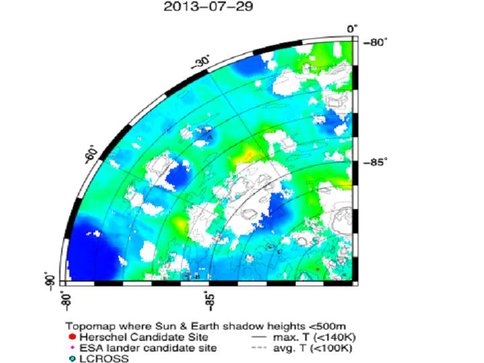2012 Annual Science Report
 University of Hawaii, Manoa
Reporting | SEP 2011 – AUG 2012
University of Hawaii, Manoa
Reporting | SEP 2011 – AUG 2012
Herschel Lunar Impact Study
Project Summary
The Herschel Space Telescope, parked in a Lagrangian point beyond the Moon, will be retired in 2013. A controlled, high velocity impact by the Herschel spacecraft into the lunar surface would provide new data about the Moon and elucidate the nature of lunar volatiles, including water ice. The impact site should be at a cold, shadowed location, but the impact plume needs to be sunlit and observable from Earth, which places significant constraints on possible impact locations. We have carried out calculations of shadow heights to identify potential impact sites that simultaneously satisfy all necessary constraints.
Project Progress
We have incorporated accurate ephemerides and lunar topography into our own Fortran program to obtain illumination geometry. We use azimuth rays in the direction of the sun and in the direction of the Earth observer to determine the height of the horizon for each grid cell on the map. In a second computational step, we calculate the depth of the shadow at each location. We then plot maps of mutual visibility, from Earth and sun, and add temperature data, neutron count rates, or other relevant data to the maps to identify suitable sites. Due to the high spatial resolution of the topography maps, these model calculations are computationally demanding and were carried out on a computer cluster.
Potential impact dates are also constrained by possible spacecraft trajectories, which need to be energy efficient. We carried out model calculations for several potential dates, and identified several possible impact sites in the southern polar region for July 29, 2013. This establishes that the Herschel spacecraft could reach a scientifically rewarding impact site, where water ice can be expected and the impact plume could be observed from Earth. On August 1, a few days later, the viewing geometry is much less favorable.
Map from the south polar region of the Moon. Candidate impact sites are where surface temperature is low and the impact plume is illuminated by the sun and can been seen from Earth.
Publications
-
Hermalyn, B., & Schultz, P. H. (2012). Excavation of the Subsurface by Hypervelocity Impacts: Insight from Experiments and Lessons from Missions. Earth and Space 2012. doi:10.1061/9780784412190.044
-
Hermalyn, B., Schultz, P. H., Shirley, M., Ennico, K., & Colaprete, A. (2012). Scouring the surface: Ejecta dynamics and the LCROSS impact event. Icarus, 218(1), 654–665. doi:10.1016/j.icarus.2011.12.025
-
Schultz, P. H., Hermalyn, B., & Veverka, J. (2013). The Deep Impact crater on 9P/Tempel-1 from Stardust-NExT. Icarus, 222(2), 502–515. doi:10.1016/j.icarus.2012.06.018
-
Thomas, P. C., A’Hearn, M. F., Veverka, J., Belton, M. J. S., Kissel, J., Klaasen, K. P., … Richardson, J. E. (2013). Shape, density, and geology of the nucleus of Comet 103P/Hartley 2. Icarus, 222(2), 550–558. doi:10.1016/j.icarus.2012.05.034
-
Thomas, P., A’Hearn, M., Belton, M. J. S., Brownlee, D., Carcich, B., Hermalyn, B., … Wellnitz, D. (2013). The nucleus of Comet 9P/Tempel 1: Shape and geology from two flybys. Icarus, 222(2), 453–466. doi:10.1016/j.icarus.2012.02.037
-
PROJECT INVESTIGATORS:
-
PROJECT MEMBERS:
Norbert Schorghofer
Project Investigator
Brendan Hermalyn
Postdoc
-
RELATED OBJECTIVES:
Objective 1.1
Formation and evolution of habitable planets.
Objective 3.1
Sources of prebiotic materials and catalysts
